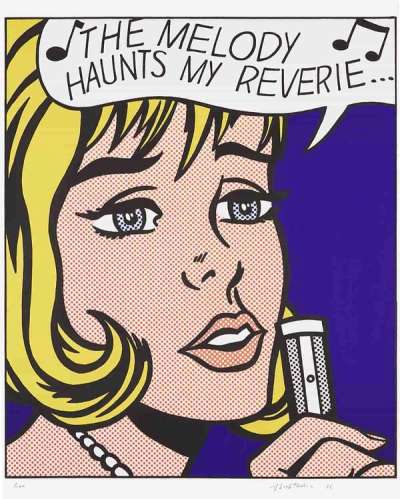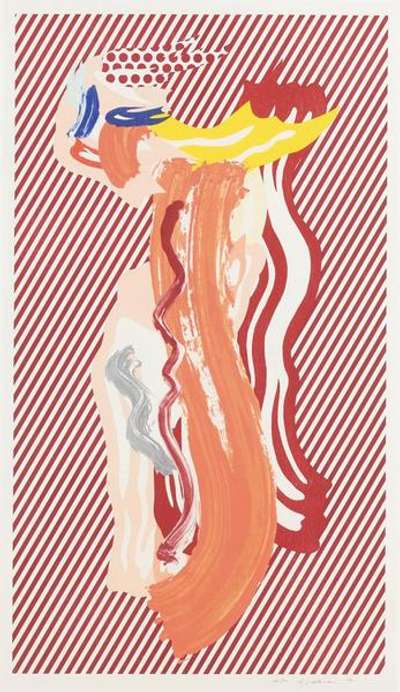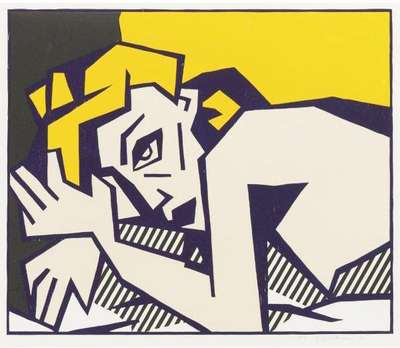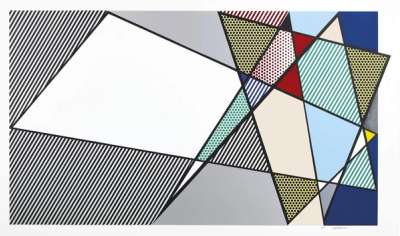 Two Nudes © Roy Lichtenstein, 1994
Two Nudes © Roy Lichtenstein, 1994MyPortfolio
Want to find out how Roy Lichtenstein prints are authenticated? Read here for Pop expert Richard Polsky's take on the matter:
Lichtenstein: Pop Art Legend
Roy Lichtenstein arguably had the highest “batting average” of all the major artists. Or, as Ivan Karp (who discovered Lichtenstein) put it, “All artists falter… accept for Roy Lichtenstein.” Back in 1961, when he appropriated comic book imagery to create fine art, he unknowingly hit on something that allowed him to transform virtually every subject into his own. Since then, his work has become synonymous with not only Pop art, but 20th century art history. Subjectively, Roy Lichtenstein’s achievement ranks him within the top ten artists of the century.
Much of Lichtenstein’s success can be traced to the work’s strong graphic content — which reproduces beautifully. This directly led to a slew of publicity throughout his career. When it came to art magazine reviews, a painting by Roy was often selected by editors to highlight the story. Other than Andy Warhol, I know of no other artist whose work translates so well to the written page. You can never underestimate this factor in the artist’s popularity. Another consideration is Lichtenstein’s liberal use of primary colours (reds, yellows, and blues) and their strong decorative content. Finally, you might say the real key to Roy’s success is that his work is easy to appreciate, whether you’re a neophyte collector or a seasoned veteran. To say you don’t like Lichtenstein’s work is almost perverse.
On the Market
Roy Lichtenstein’s canvases are a surefire bet on the secondary market. The artist’s classics from the 1960s rarely come up for sale. Even the works from the 1970s and 1980s are highly sought after and hard to acquire — at any price. In the event the art market ever goes into a recession, the three artists whose prices are most likely to hold up are Andy Warhol, Alexander Calder, and Roy Lichtenstein.
Original Prints
Original prints are an important part of Lichtenstein’s oeuvre; he produced over 300. Always a strong printmaker, Lichtenstein became better at his craft over time, as his prints grew in scale and complexity. Much of his growing ambition as a printmaker can be traced to his collaborative efforts with the master printer Kenneth Tyler of Tyler Graphics. As Lichtenstein’s prints grew larger and more elaborate, they became harder to counterfeit. Yet, that never seemed to stop some unscrupulous individuals from trying.
In recent years, we have examined several works from Lichtenstein’s “Nude Series” (1994). Specifically, we spotted bogus copies of the prints Nudes with Beach Ball, Girl with Ball, and Nude with Blue Hair. Rather than the correct print medium of serigraphy, these impressions were offset lithographs — a commercial process akin to printing posters. Another tipoff was these prints were a few inches smaller than the genuine copies. Whenever you buy a Lichtenstein original print, always be sure that the print medium is correct and that its dimensions are consistent with the original.
There have always been problems with Lichtenstein’s two major early prints: Reverie and Sweet Dreams Baby! But in these cases, the biggest issue for collectors has been to avoid copies that were sun damaged. This led to the unethical practice of sending faded examples to a printer to rescreen the copies. Thus, the caveat with these two prints is that if you’re offered one that appears to be in pristine condition, make sure you hire a professional art conservation lab to examine it, before writing a check.
Leo Castelli Gallery Prints
One of the more complex issues in authenticating Lichtenstein’s prints is being able to distinguish the difference between his published prints and the Leo Castelli Gallery prints and posters — done between 1962-1967. Leo Castelli, who became Lichtenstein’s exclusive dealer in 1962, issued offset lithographs specifically designed as exhibition announcements (many of them have visible folds). But that doesn’t mean they’re not valuable. Many are signed and numbered. Among the best of the group are: Shipboard Girls, Sunrise, Modern Art Poster, Crying Girl, Foot and Hand, and Brushstroke.
Many of the Leo Castelli Gallery prints were done in an edition of 300. However, according to Ivan Karp, these giveaways proved so popular that they often printed an extra 300-350 for each show, and then sold them for a few dollars apiece (to cover printing costs) at exhibition openings. Karp also stated that Roy signed many of these overruns as a courtesy. For this reason, it’s impossible to know how many were actually done, and how many were signed. The fact they were printed on inexpensive paper also took their toll as many of them fell apart after being taped to walls. You also have to assume a fair number of them, which were sent to individuals on Castelli’s mailing list, were thrown away.
Another consideration is Roy Lichtenstein’s intent behind the Leo Castelli Gallery prints. During the 1960s, he completed a number of original prints (including Reverie and Sweet Dreams Baby!) which were intended to represent him as fine art — just like his drawings and paintings. The Castelli prints were issued for promotional purposes. Although they were well-executed, they were not done with the intention of being viewed as fine art.
A good comparison are the psychedelic rock posters from the 1960s, used to promote concerts by the likes of the Doors, Jefferson Airplane, and the Grateful Dead at San Francisco’s Fillmore, Family Dog, and Winterland venues. However, their graphic quality was so amazing, that people began taking them from storefronts, telephone poles, and bulletin boards — and they became highly collectible.
Signatures
Collectibles aside, another sign that a Roy Lichtenstein print has problems is a forged signature. In general, the artist’s signature is usually the easiest part of a print to fake. However, Lichtenstein’s signature is a little more complex than most. With that in mind, if your “radar goes off” that you might be considering a less than kosher work, always try to compare the signature to one on a print known to be genuine — you should be able to tell the difference. In summary, there are far fewer fake Lichtenstein prints than Warhol prints and Keith Haring prints. But that doesn’t mean you shouldn’t be vigilant.

















